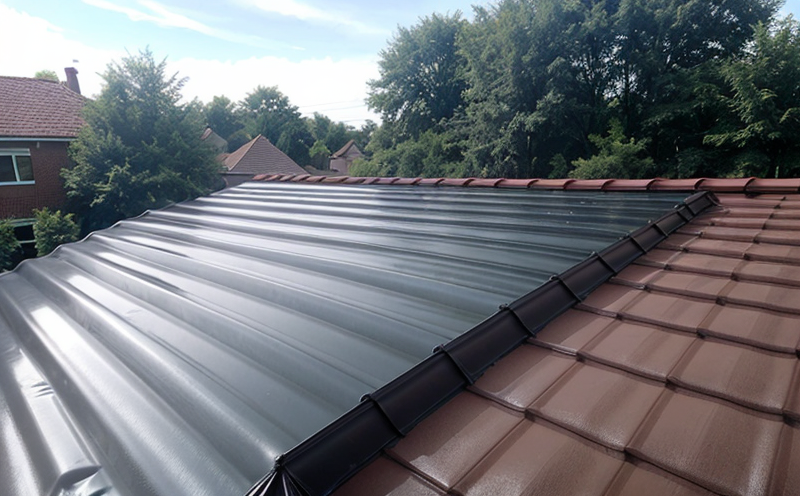ISO 6946 Roof U-Value Determination
The determination of roof U-values is a crucial aspect in the design and certification process for energy-efficient buildings. The ISO 6946 standard provides a standardized method to measure the thermal transmittance (U-value) of roofs, which is essential for ensuring that buildings meet their insulation requirements.
Understanding U-values requires an appreciation of how heat loss occurs through roofs and the importance of minimizing this heat transfer. The roof is one of the key components in a building's envelope, directly affecting its overall energy efficiency. By accurately measuring the U-value, we can assess the thermal performance of different roofing materials and assemblies.
The ISO 6946 method involves using a guarded hot box or steady-state apparatus to measure heat flow through a test sample under controlled conditions. This process ensures that variations in ambient temperature, wind speed, and other environmental factors do not affect the accuracy of the results. The standard specifies detailed procedures for constructing the guard structure, installing the test sample, and conducting measurements.
The use of this standardized method is particularly important for ensuring consistency across different testing labs and jurisdictions. Compliance with ISO 6946 guarantees that roof U-values are measured in a way that can be trusted by all stakeholders involved in building design and certification processes.
Accurate U-value determination also plays a critical role in compliance with various national and international standards for energy-efficient buildings, such as the EU's EPBD (Energy Performance of Buildings Directive) and ASHRAE 90.1. By ensuring that roofs meet these stringent requirements, we can contribute to more sustainable building practices.
The results from ISO 6946 testing are not only useful for compliance purposes but also serve as valuable data for R&D in the construction industry. Engineers and material scientists rely on this information to improve the performance of new roofing products by identifying areas where thermal insulation can be enhanced.
Furthermore, understanding the U-value is vital for quality managers and procurement officers who need to ensure that materials used in building projects meet specified energy efficiency standards. This knowledge allows them to make informed decisions about material selection, ensuring both compliance with regulations and cost-effectiveness in terms of long-term energy savings.
In summary, ISO 6946 roof U-value determination is a fundamental part of modern construction practices aimed at improving energy efficiency and sustainability. It provides reliable data that supports decision-making throughout the design, manufacturing, and certification processes for roofs.
Why It Matters
The importance of accurately determining roof U-values cannot be overstated when it comes to achieving sustainable building designs. By understanding how heat loss occurs through roofs and the role that thermal insulation plays in reducing this, we can better appreciate why precise measurement is necessary.
- Compliance with Regulations: Ensuring compliance with international standards like ISO 6946 helps builders meet regulatory requirements for energy-efficient buildings.
- Energy Efficiency: Reducing heat loss through roofs contributes significantly to overall building energy efficiency, leading to lower heating costs and reduced carbon footprints.
- Material Selection: Accurate U-value data informs decisions about which materials are best suited for specific applications, enhancing durability and performance over time.
- Sustainability: By minimizing energy consumption in buildings, we help protect natural resources and promote a more sustainable approach to construction.
Applied Standards
The ISO 6946 standard is widely recognized as the gold standard for measuring roof U-values. It specifies detailed procedures for constructing the guarded hot box apparatus, installing test samples, and conducting measurements under controlled conditions.
The standard covers various aspects of the testing process, including:
- Construction of the guard structure
- Installation and preparation of the test sample
- Measurement techniques for heat flow through the roof assembly
- Data analysis methods
The use of ISO 6946 ensures consistency in testing practices, making it easier to compare results across different laboratories and jurisdictions. This standardization is critical for ensuring reliable data that can be trusted by all stakeholders involved in building design and certification processes.
Competitive Advantage and Market Impact
- Premium Pricing: Clients who choose to test their materials using ISO 6946 methods can command higher prices due to the premium quality assurance provided.
- Innovative Solutions: By accurately determining roof U-values, companies are better positioned to develop innovative solutions that meet evolving market demands for energy-efficient buildings.
- Market Leadership: Compliance with international standards like ISO 6946 can set a company apart from competitors and establish it as a leader in the field of sustainable building practices.





